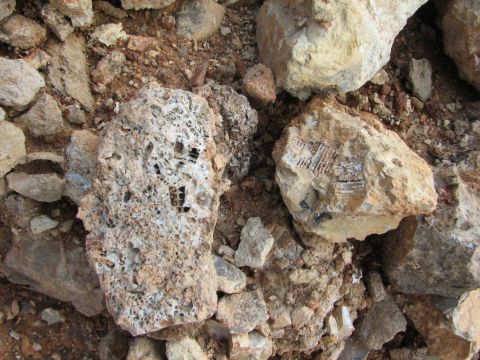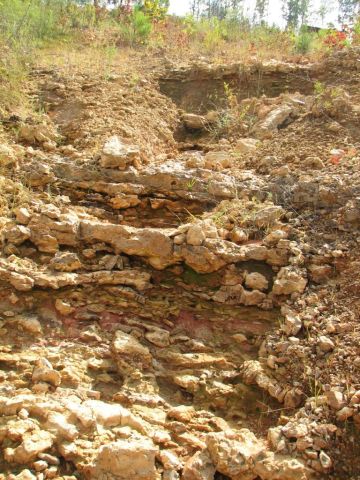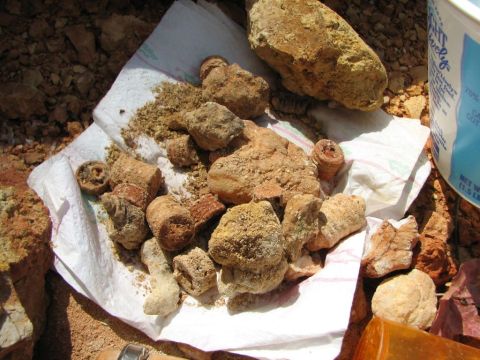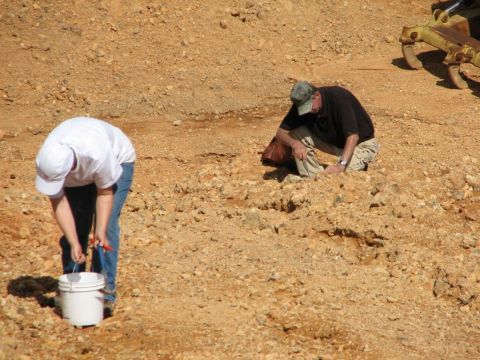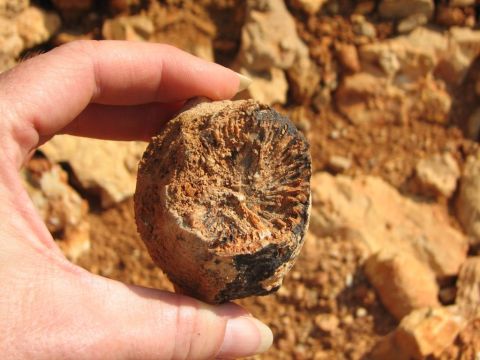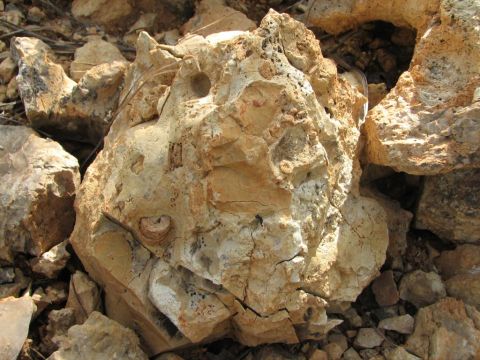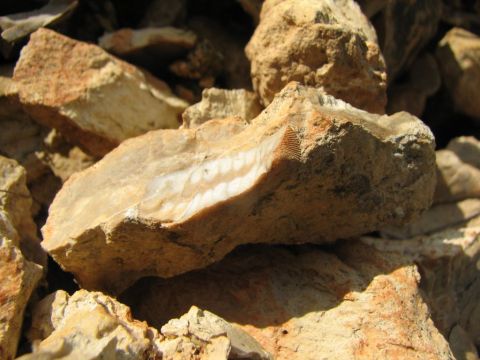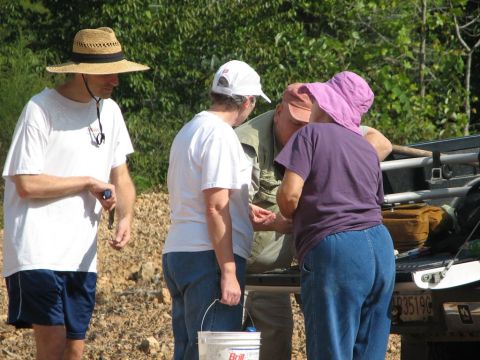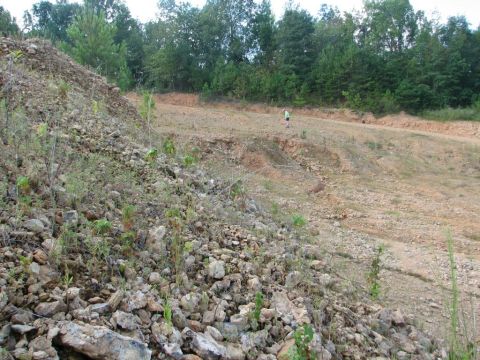Visitor
crinoid
September 22, 2007 - Mississipian Fossils, Blount Co, AL
A trip to a quarry in the Mississippian age, Fort Payne chert was on the schedule for BPS' field trip in September. It was a beautiful day with a good turnout. THe quarry had been dug out since out last visit so we were able to look around the freshly-exposed areas. Sylvie and Michael made a heroic effort to find a trilobite in some of the material that resembled Frog Mtn. formation, but to no avail. We wandered freely over the huge quarry area, finding crinoid stems, brachiopods, corals and a number of nice geodes. The chert is lightweight and filled with cavities, leaving behind molds of long-ago crinoids.
Lunch break at the Top Hat Barbecue gave us a chance to cool off a little, since the heat was pretty intense. However, the troops headed back to the quarry after lunch for a full afternoon of collecting.
--Photos courtesy Vicki Lais
- ‹ previous
- 3 of 4
- next ›
February 17, 2007 - Mississippian Fossils, Franklin Co, AL
Once again, the word, "intrepid" comes to mind when BPS makes a midwinter trip! With the temps in the upper 30's and low 40's and 15-20 mph winds, it was a toss up as to which trip to this site was the coldest! In spite of the weather, around 23 fossil seekers came for the fun. Our first stop was under sunny skys and slight winds which brought the temperature up to a bearable level. This is a great site, featuring a prehistoric coral reef that always has excellent specimens washed out during the previous year. It's always a temptation go after the big boulders, but they're much larger than they look (like iceburgs) so we can only stand and drool and capture them on camera. At the first stop on the lake numerous specimens of blastoids, archimedes, and crinoid stems were found, and a very nice piece of petrified/ permineralized wood. Next we went to the other side of the lake where it was downright windy and bitter cold. More crinoid stems, straight cephalapods, and some unknown specimens were collected as well as great slabs of fossil hash. These make great teaching tools as well as attractive showpieces. We were also treated to the sight of Bill "walking on water!" Next we stopped at a roadcut which yielded a few more nice specimens, and a lot more icy wind. After one last site check, hunger was the issue, so most of the group organized to follow Greg, who always seems to know the best places to chow down, to a long enjoyable evening meal at a "secret" local steak house, After a great time of good food, rehashing the day and catching up, tired BPS members headed home.
--Edited by Vicki Lais
(Photos courtesy Jan Novak, Bill Fowler, Chris Lais, & Vicki Lais)




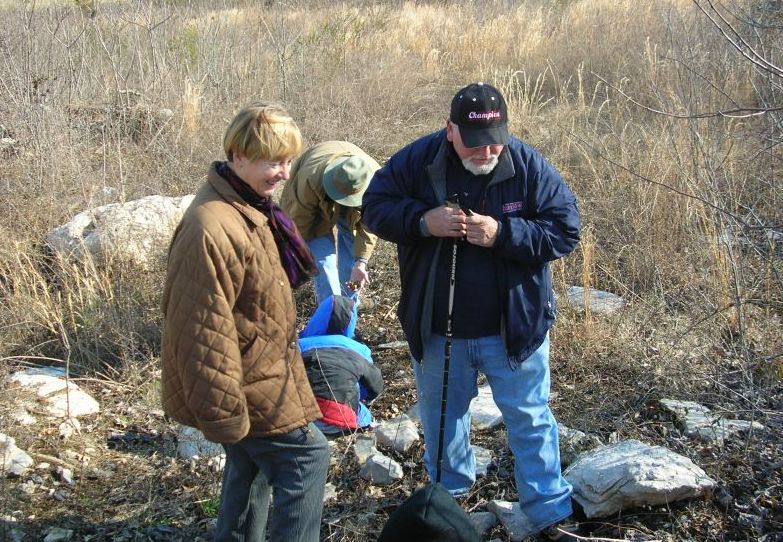





On to the next stop, where we were given an overview of the collecting area.

Shoreline of the lake, water is way down in winter.

Horned coral.

A sponge?

Horned coral.

Nice brachiopod.

Most rocks in the area consist of numerous small fragments of fossils. Most visible on this specimen are crinoid stems and bryozoan (or the netting material from archimedes.)

Parts of very large, but broken, blastiods.
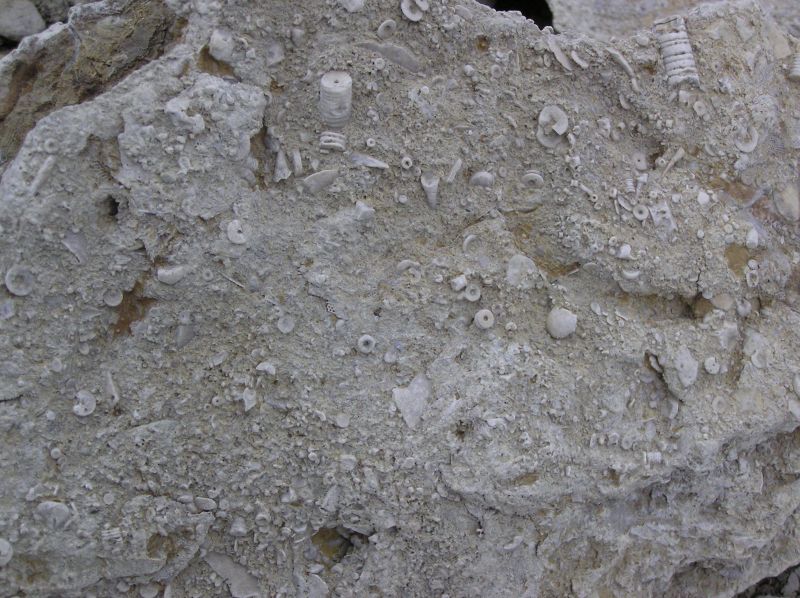

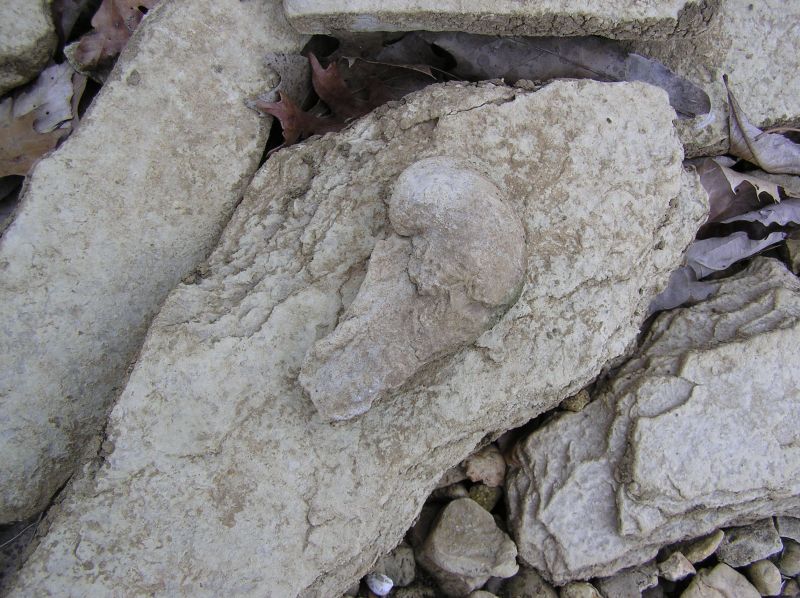
Tiny gastropod.


Unknown round fossil.


Another unknown fossil.

Very nice specimen of petrified/permineralized wood.

How'd he do that?? Bill has found several nice specimens. Click, then click again for larger image.

Nice cephalopod.

Brachiopods.


After the lake, we collected at a nearby roadcut.

Numerous specimens of burrow casts were found, and also a few straight cephalopod's (in middle).

At the last stop of the day, geologic layering is very prominent.


Tall people have a distinct advantage!
December 16, 2006 - Mississippian & Ordovician Fossils, Jefferson Co, AL
Since the grey-on-grey of the limestone makes it difficult to photograph the details clearly, Chris took multiple photos of the boulder, then used “stitch” photo technology to create detailed photographs of the complete rock surface. By using extreme macro and pasting the sections together, we have gotten far better records of those surfaces and the fossils they contain than with past techniques.
The Ruffner Mountain quarry is a fascinating place to visit and learn more about the Alabama fossil record. BPS is glad that we can contribute to the educational services of the Nature Center by our documentation.
After a late lunch at a locally famous hamburger joint, it was time to head home and get ready to party! All-in-all, a great day, topped off by the annual Xmas party. Good company, good food, Dirty Santa, a lot of laughter, and live music from our very own Lea Novak. It doesn’t get much better than that!
--Edited by Vicki Lais
(Photos courtesy Chris and Vicki Lais)
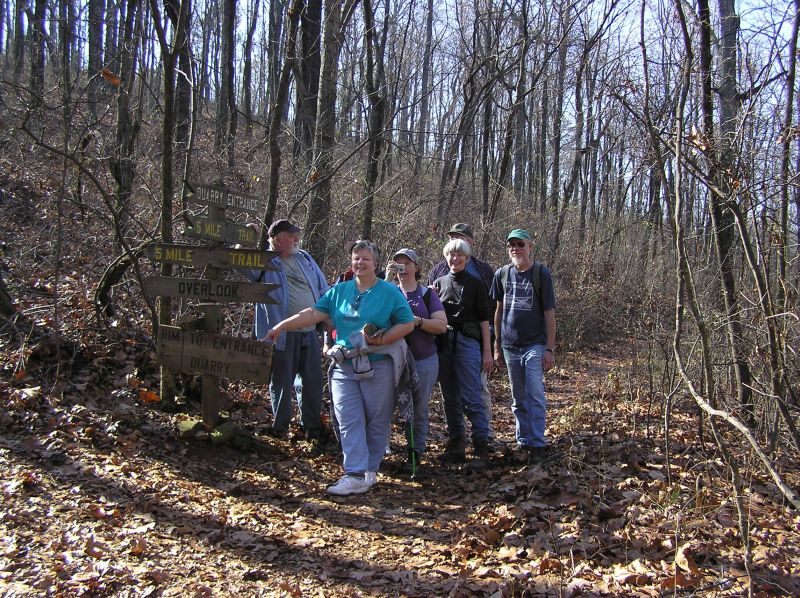
Part of the group deciding which way to go.
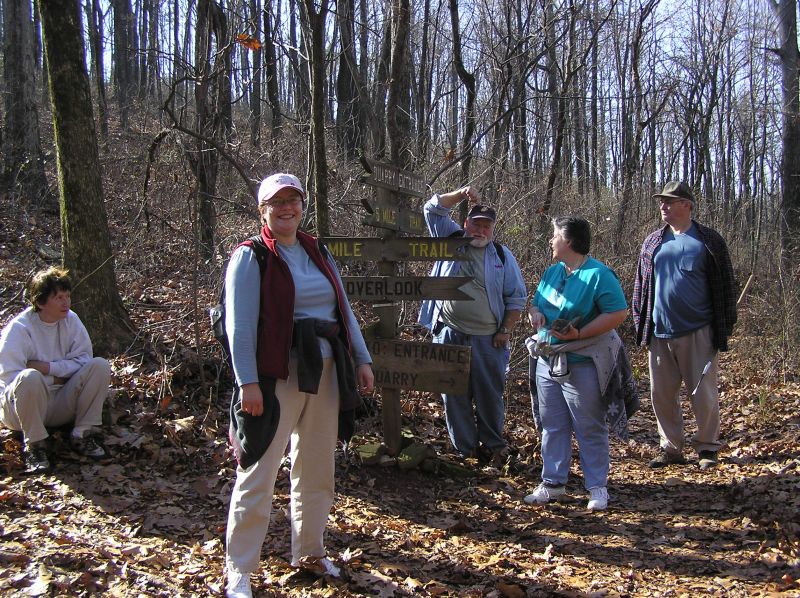

Iron ore spotted on path to quarry.

Mixture of fossils including brachiopods and bryozoans.

Most of the fossils are badly weathered.

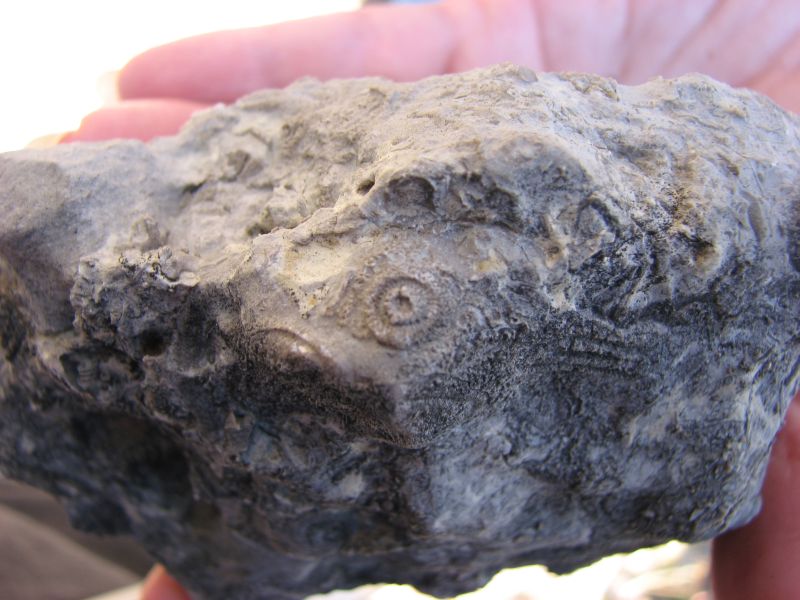
Coral.



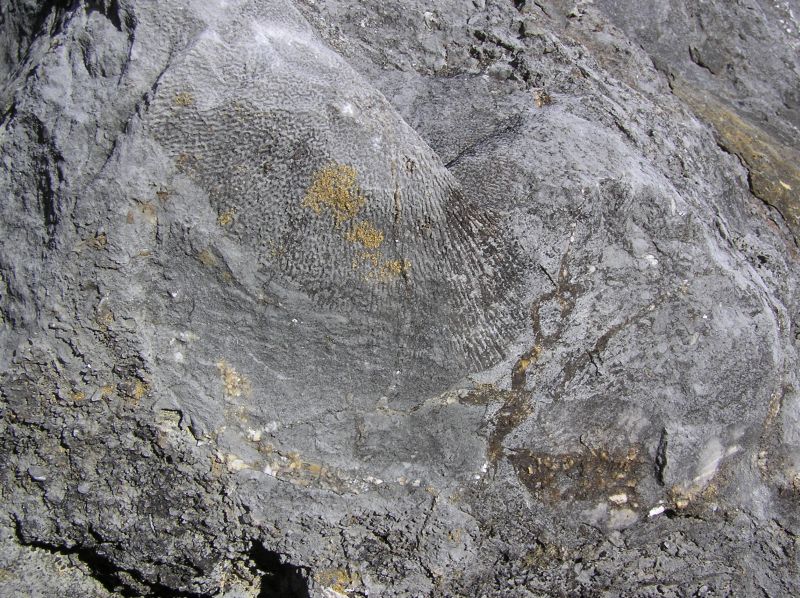
Large coral in boulder.

Another view of the same coral.

This is very tiny, no more than 1/2 inch across (My apologies for lack of a scale). Dr. Phil Novack-Gottshall says this appears to be a diploporitan, a type of echinoderm .
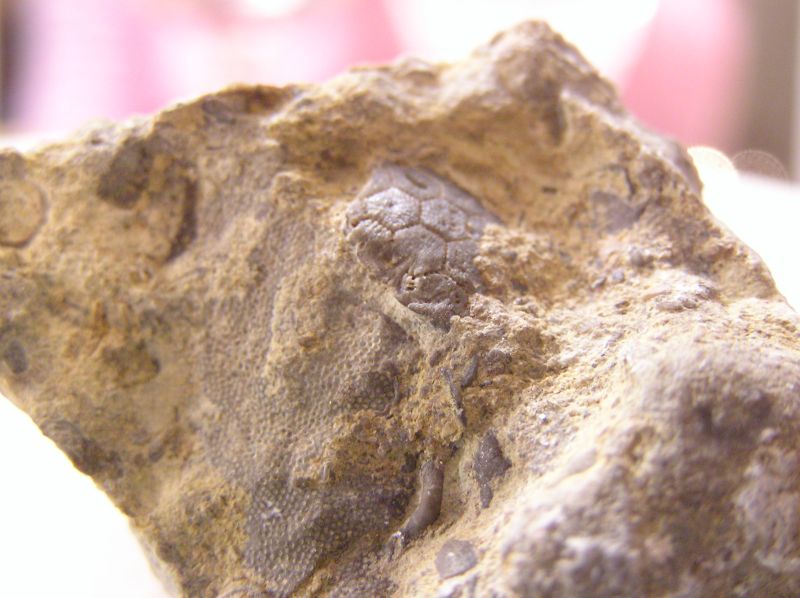



Taking a break.

This is the rock/boulder that has been etched so that more fossil material is visible.

A closer view.



This odd looking fossil had us speculating, but according to Dr. Phil Novack-Gottshall, it is a crinoid stem with very regular cirri.

A macro view of the unusual crinoid stem.



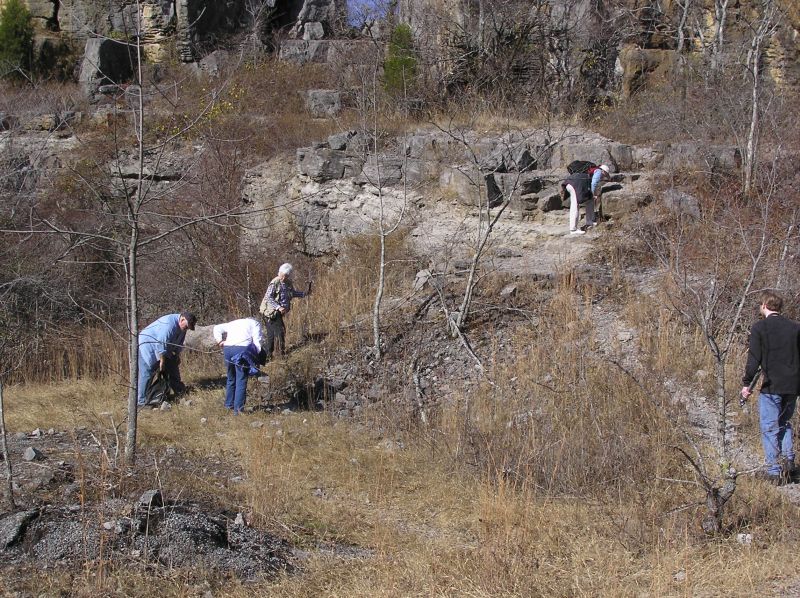


September 30, 2006 - Paleozoic Fossils and Rocks, Jefferson Co, AL, Part 2
Page 2 - Fossils and minerals (this page)
(Photos courtesy Chris and Vicki Lais)

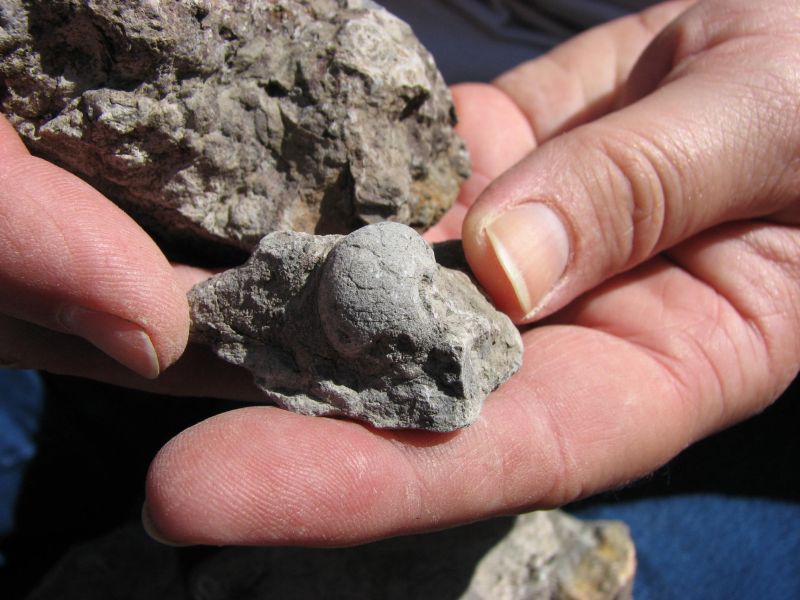


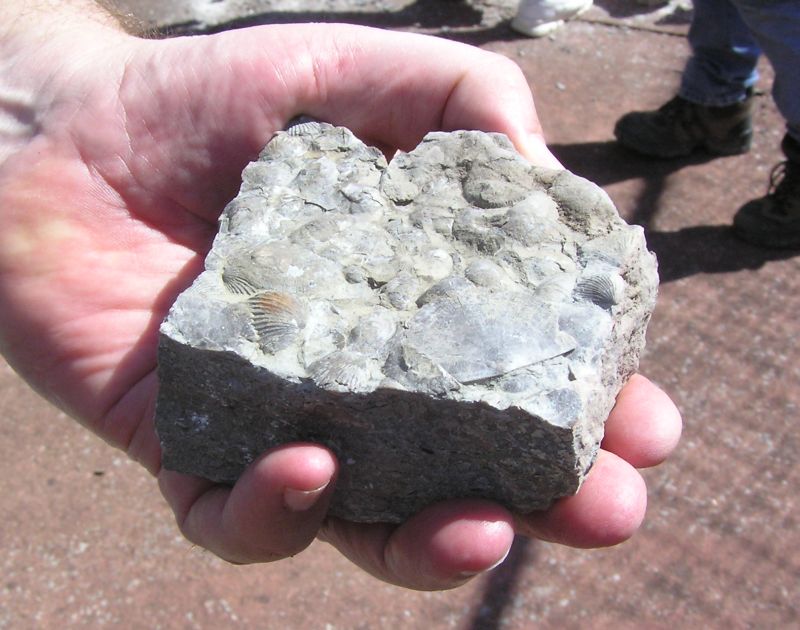




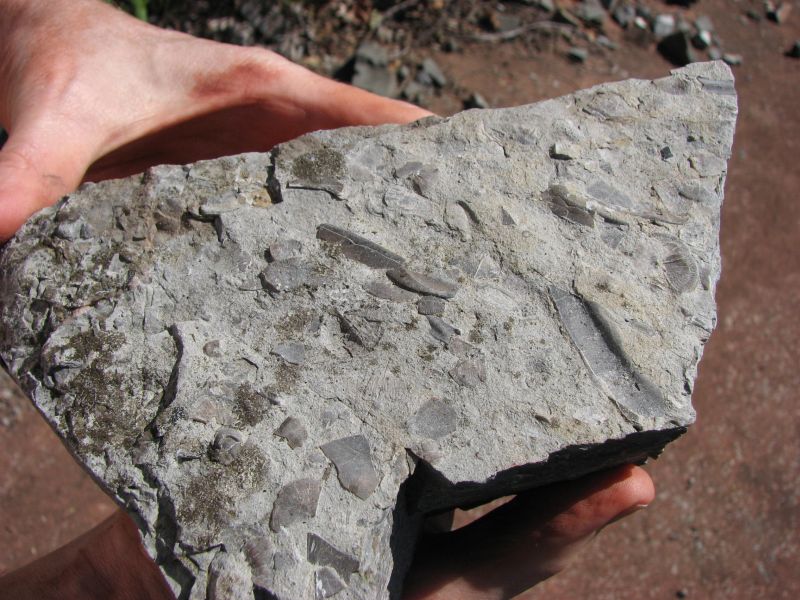







And some mineral specimens:

Hematite

White calcite crystals.

Pink calcite (dolomite) crystals.
Page 1 - General trip photos
Page 2 - Fossils and minerals (this page)
March 18, 2006 - Mississippian Fossils, St. Clair Co, AL
BPS members collected in St. Clair county, Alabama this month. The weather started out a little chilly, but turned into a perfect, pleasant day. The first stop was a Mississippian age road cut, where geologic uplift is obvious. There we found several varieties of coral, including quite a few large horned coral, brachiopods, and sponges in layers of the Tuscumbia Limestone. The Ft. Payne chert contained numerous hollow molds left by archimedes and crinoids. After we had decided to stop collecting (let's see, Leisa decided this how many times???) and were winding up to go to the the next site, Michael split open a rock and found a trilobite. Well, we had been looking for the correct layer for several hours with no luck, so this set off another search for the "correct" rocks in the "correct" layer, and everyone began splitting rocks, hoping for a nice trilobite. A local landowner stopped by to ask what we were doing, and once he found out, offered to let us drive across his property to an old quarry and check it out. We already had a second quarry site in mind where local people fish, however, both quarries turned out to be overgrown, with large boulders, and in a very quick assessment, we found no fossils. All was not lost - the ride to the quarries was quite exciting, and we enjoyed the scouting trips and being out in the woods on such a glorious day. Good memories of time spent with friends.
Edited by Vicki Lais
(photos courtesy Steve Corvin and Vicki Lais)


Greg is explaining how to spot the fossils.

Look closely in the rocks and several horned corals and broken pieces can be spotted. They blend in well.


Michael has found a couple of items we believe to be sponges.
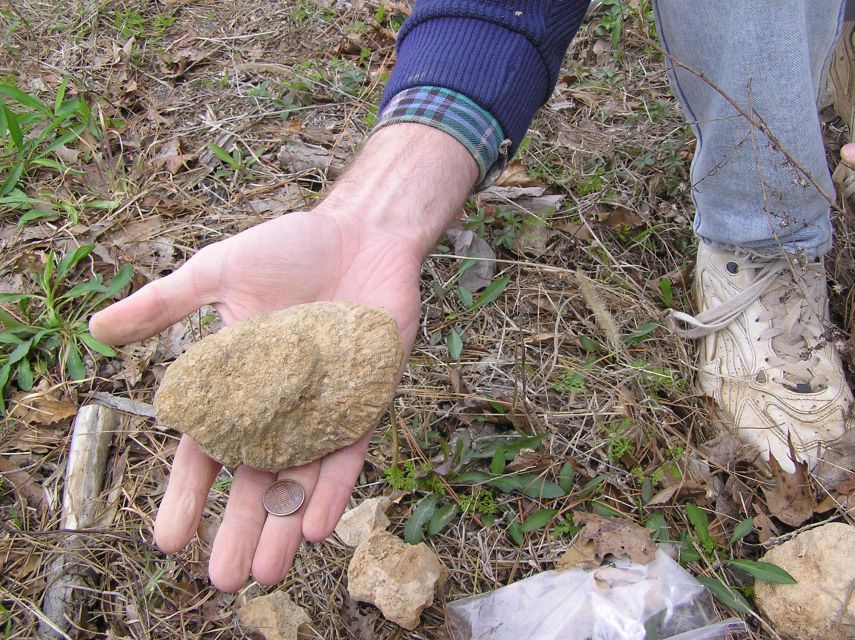

More rocky area, with numerous fossils waiting to be collected.


Another view of the ground littered with broken and whole fossils.

Steve is heading to the top, to see if there are different fossils up there. Or, maybe he just likes to climb!




Some interesting fossil material found by Steve.

Note the nice brachiopods.


Claire has found a nice coral head.
 More nice finds by Claire.
More nice finds by Claire.

Another nice specimen, probably coral, found by Vicki.

Michael and Sylvie showing off their coral and sponges.
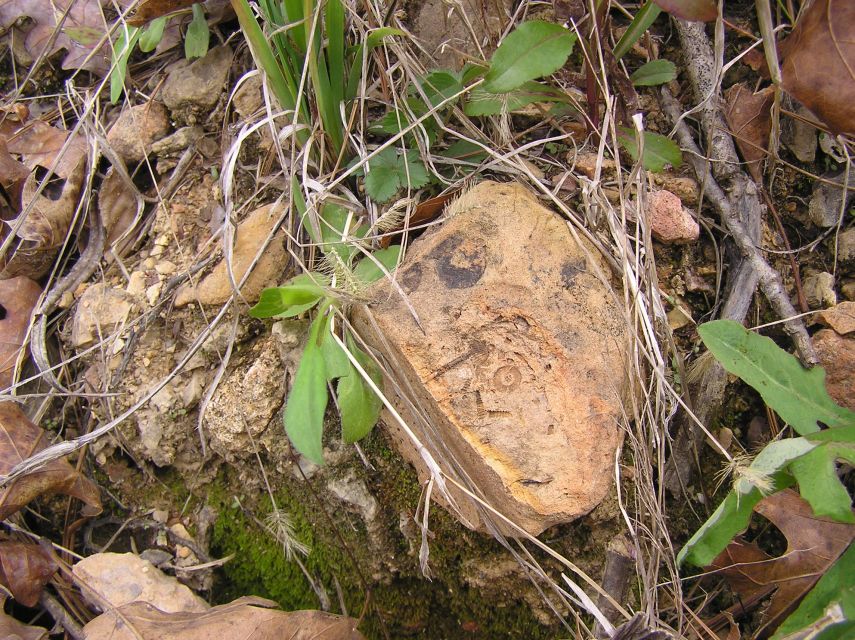

Note the nice shell on the upper rock in the middle. When the fossils are the same color as the matrix, they are difficult to spot.

Crinoids have left impressions on these rocks. A different area from where the coral is found.

Greg and Michael searching for the trilobite layer.

Leisa has found some nice horned coral.

A closer look at Leisa's finds.


After diligent searching, Michael found the trilobite layer!
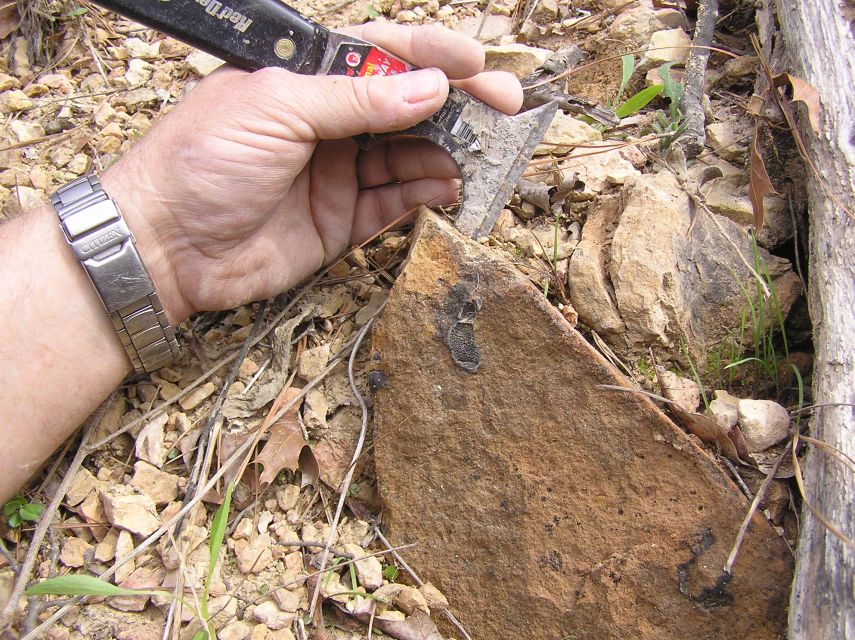
Greg has found part of a trilobite - the black coloration at top of rock. The larger oval is the head, the smaller one is an eye.

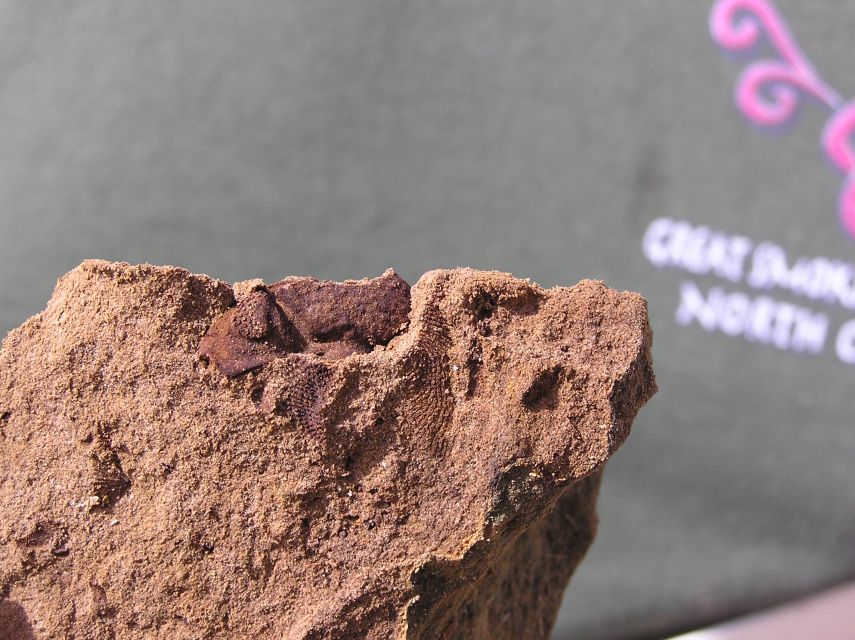
A close view of a trilobite.

We briefly scouted this quarry and found some interesting structures and fish, but no fossils.
December 3, 2005 - Lawrence, Franklin and Colbert Co, AL
Back in the car headed to site #2, and it began raining again. Darn! As the drizzle quits, someone suggests a side trip to the lake, to check the water level, and much to our delight, it was way down, so we added an unexpected new stop, where everyone found a number of crinoid stems, blastoids, archimedes, an unknown trace fossil, and horned coral. One comment was "How many days do we get to spend here?". The weather got warmer, and became very pleasant, even without coats (a real thrill to those of us who remember many collecting trips tolerating the icy cold wind that normally whips around the point most of the winter). In keeping with our international flavor, two guests from Japan (who have only been in the US since July) joined us for their first ever-fossil trip. We may have spoiled them. NO you DON'T find fossils on every spot of ground in Alabama!
Then, when Greg was able to tear us away from the lake, on to the next location, site #3, a popular road cut in Colbert County, where nice blastoids, archimedes, and straight cephalopods were found. Also, an outstanding question was answered. On our August 2005 field trip, an odd, lightweight, heart shaped disk was found in Montgomery County that we couldn't identify. On one of Vicki's side excursions today, she found part of a vertebra column, probably of a deer, and several of the heart-shaped cartilage discs were found in place. Now we know - not a fossil, but very interesting.
The 4th stop had a few specimens, but not enough to linger.
At that point, part of the group went to an additional site, where there were nice fossils, mostly still in matrix. This site contains metallic, cubic mineral specimens that have not yet been positively identified. They look similar to pyrite, but are the wrong shape and color. They are small, about 1/4 inch, cubic, shiny reddish-gold copper colored, and heavy for their size. The square sides aren't exactly straight, since they have a dip in the middle. They could possibly be limonite after pyrite.
After that, the entire group met up again, and headed to an off-the-beaten-path steak house in the middle of nowhere to wind down for the evening and enjoy each other's good company before starting the long trip back home.
(photos courtesy Lea Martin and Vicki Lais)
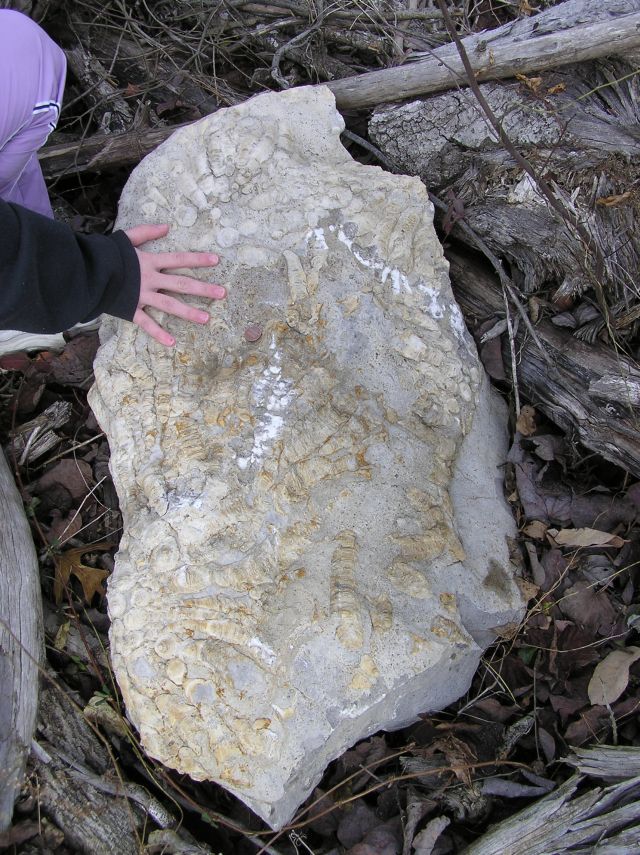
The first stop produced very large specimens of rugose coral, most too large to carry.

Leisa, our Pres, and new members Hitoshi and Yakari on their first fossil trip... Welcome to Alabama!

Paige just needs her picture taken since she is so photogenic. What a nice specimen of coral she's found!

Jan and Greg searching for loose corals.

One of the nicest specimens.
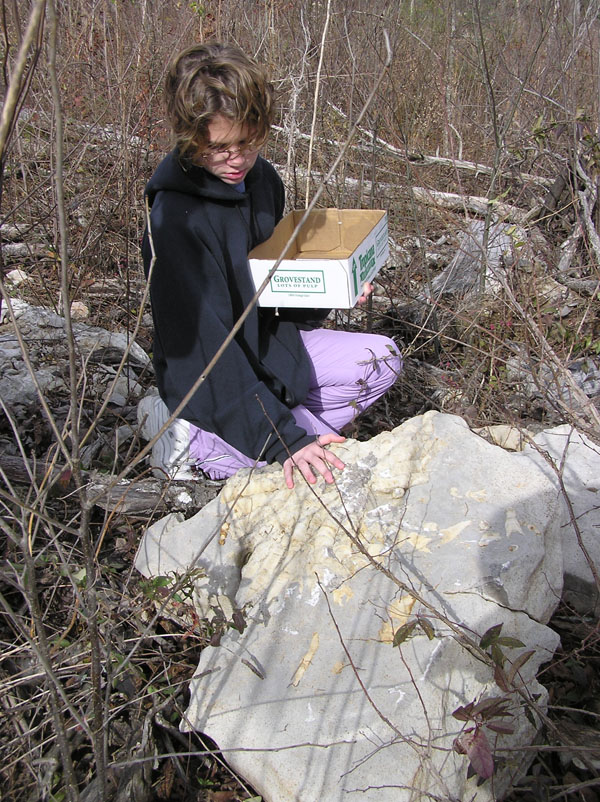
Uh.... Paige..... I don't think it will fit in your box......


Lea Novak has lugged this large coral to her car.
On to site #2 -

Most of the rocks on this lakeshore are filled with small fossils. Most plentiful are crinoids, blastoids, archimedes, and horned corals.
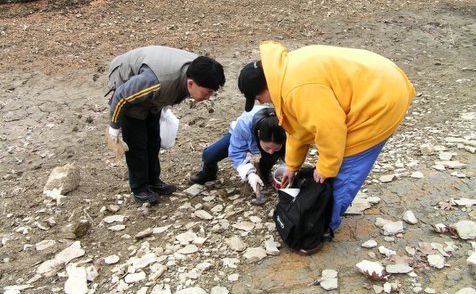
Leisa showing our newest members fossil specimens on the rocks.

Greg has found a nice slab to show how plentiful fossils are in this area.

Every rock here is covered with fossils. So why search? Some rocks have weathered more than others, and the fossils are in nice relief. Some have more "perfect" examples, some have more of the "pretty" fossils, or displayed a larger variety.


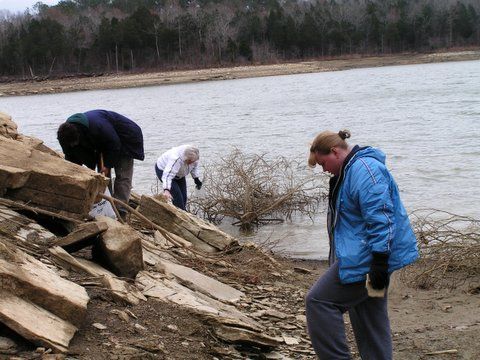
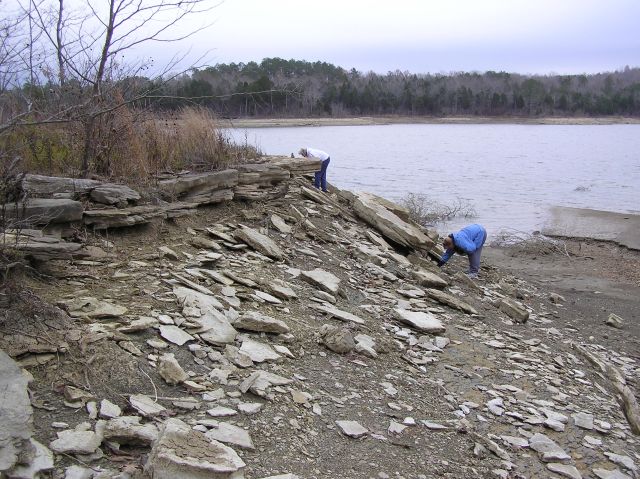

Melanie has found a nice.... well....umm.... trace fossil??
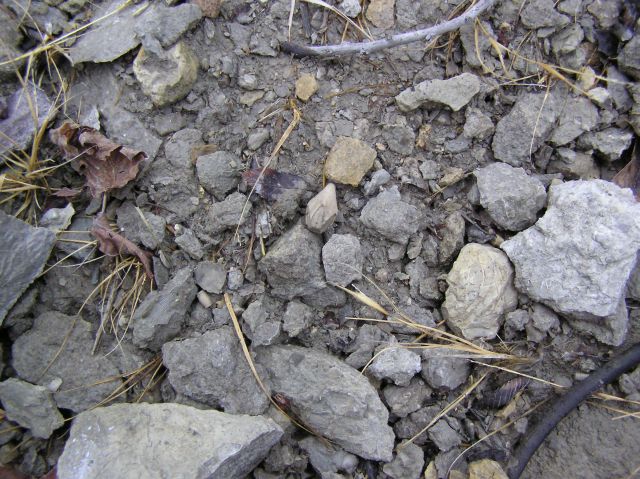
Look carefully in the middle of the photograph to see a blastoid.

Closer view of blastoids.

Hi, Claire!

Hard to see, but this boulder is covered with very tiny crinoids, probably a breeding area.
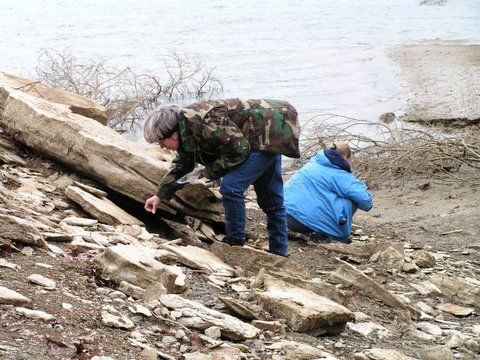
Stop #3 is a roadcut -
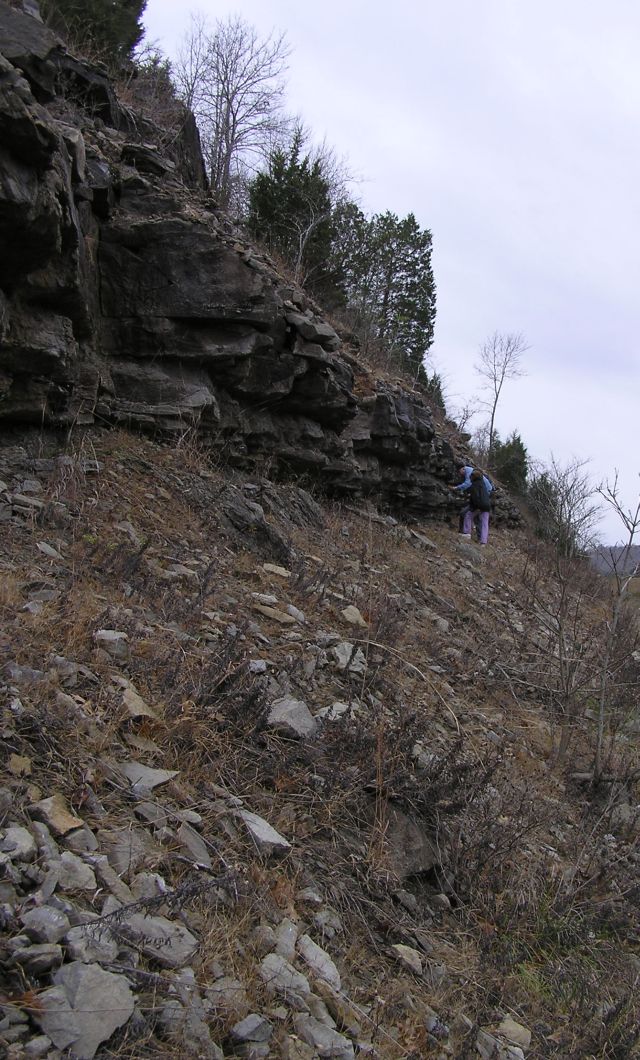
Blastoids, horned coral, and archimedes were found in this area.


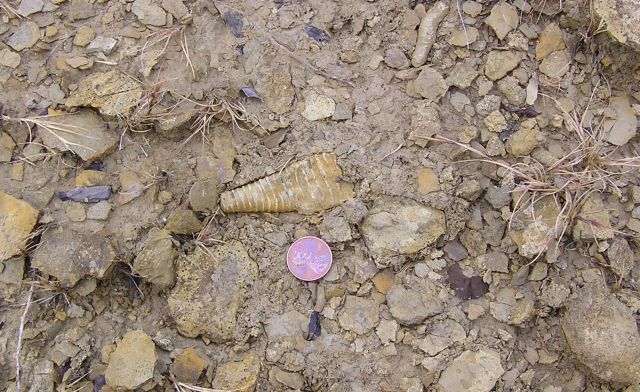
A few straight cephalopods were also found.
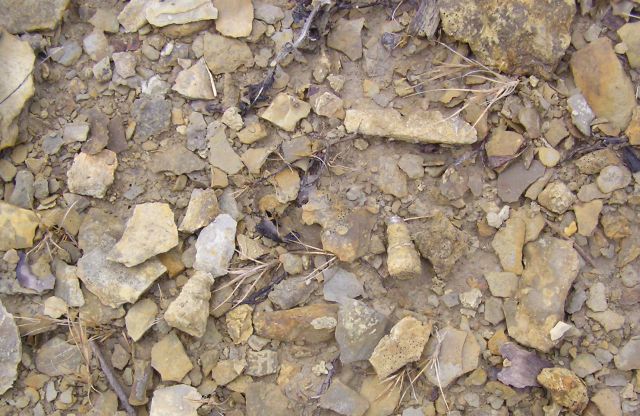
Some fairly worn specimens of horned coral.
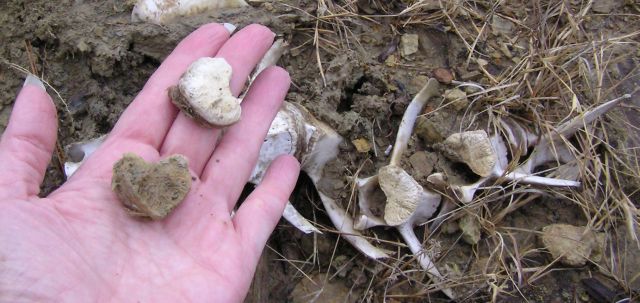
Another mystery solved. A heart shaped item had been found on our Montgomery trip, but no one knew what it was. Several of them were found in place today - in a deer spine. They are the discs between vertebra.
Stop #4 - another wash in a roadcut.

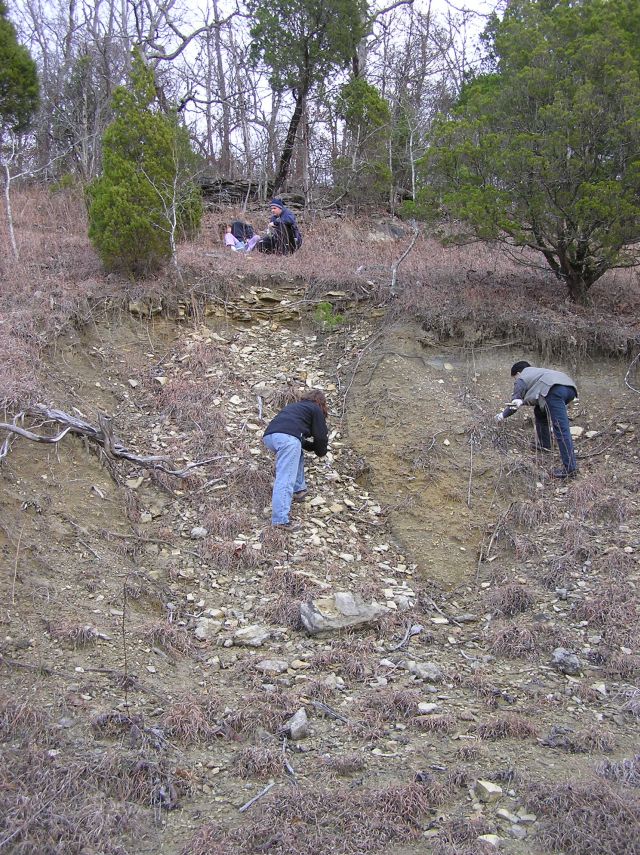
Very little was found at this location, but we had fun looking!
While most of the group headed for the local watering hole, 3 members proceeded on to stop #5:

A beautiful layer of bivalves is now exposed. Impossible to collect without damaging the specimens, so we collected only photos.

A closer view after cleaning. They are heavy, and may be pyrite. Possibly limonite after pyrite.
November 20, 2004 - Mississippian Fossils, St. Clair Co, AL
Donning orange and blue, red and white, or...mud and well, a little more mud, the BPS explored a new site in St. Clair County, Alabama. The weather was just a tad misty after our outing but cool and comfortable during our adventure. Our fearless leader led us to a Mississippian age roadcut yeilding some of the largest horn coral that I have seen, with a perfect geologic example of "uplift". Several varieties of coral were found, and a number of whole brachiopods were collected from the layers around the Tuscumbia Limestone. There were also hollowed out molds in the Ft. Payne chert where archimedes or crinoids had once been.
We scoured an unused chert quarry and spotted another possible collecting site which we plan to survey once permission has been obtained. Our day also included a tour of sites important to the history of Alabama and the United States. Some good camping sites were also noted.
None of our members minded that our actual collecting time was shorter than on many of our trips, as most members were eager to put their orange and blue or red and white clothing to use as they "collected some radio and television time", because there was some important football game being played....tiny mumble...mumble...#*%...how did we manage to vote on this weekend for the field trip in the first place????????
MY TEAM WON!!! How 'bout yours?
--Edited by Vicki Lais
(Photos courtesy Steve Corvin and Vicki Lais.)

The group before playing in the red clay!

Leisa and Nancy checking for fossils weathered out of the matrix.
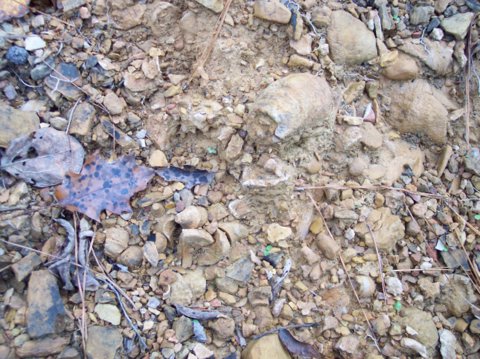
Coral pieces covering the ground in this area.
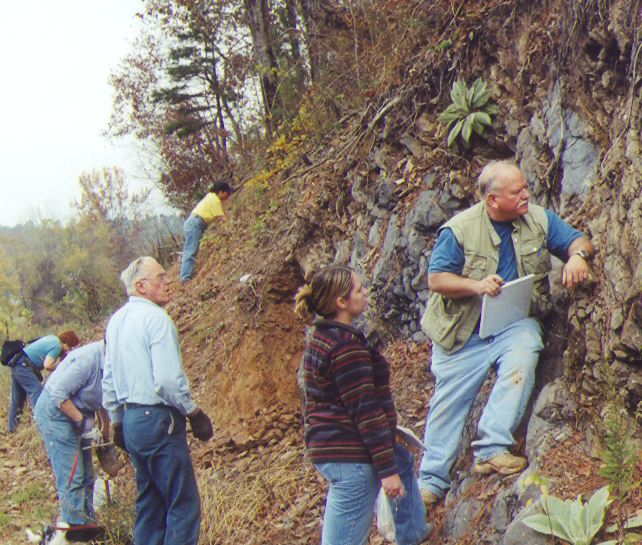
Getting a closer look at the geologic layers.

Lee with her finds.

A closer look at the nice coral specimens found by Lee.

Steve is determined to get that fossil!

One of the better collecting spots.

Layers of limestone, shale, and mud tilted upward by geologic forces, and exposed at a roadcut. "Newer" rock is to the right, "older" rock is to the left. Rock layers were horizontal when they were initially formed.

One of the muddier collecting spots!
October 2, 2004 - Lawrence and Colbert Co, AL
Stop #1 was a roadcut in Lawrence County, Alabama, where large pieces of rugosa coral in Bangor Limestone had been excavated by road construction. The site has almost been totally reclaimed, but some very nice specimens were found.

A large coral head.

Hunting for treasures. The site has become overgrown, making it more difficult to spot the coral pieces.
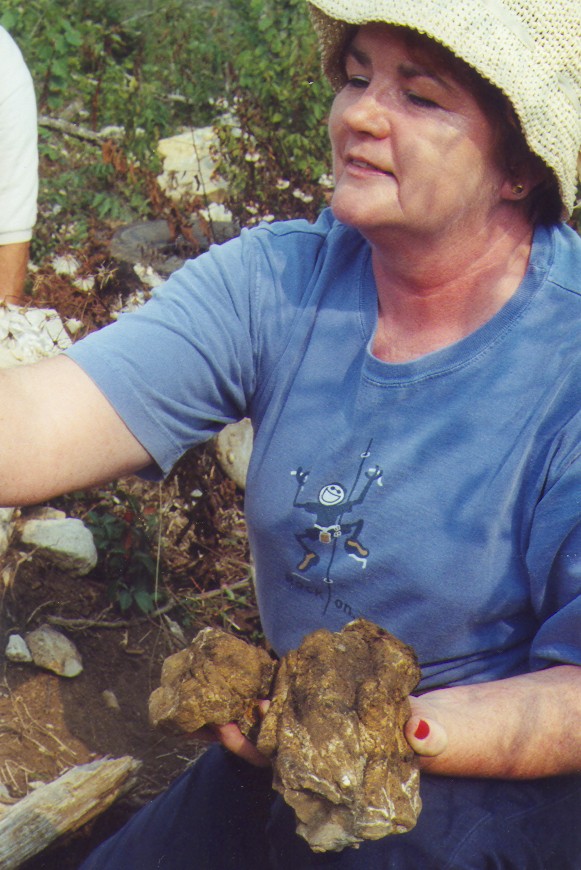
Carolyn with a couple of coral clusters.

Bobby in foreground, with James in back.

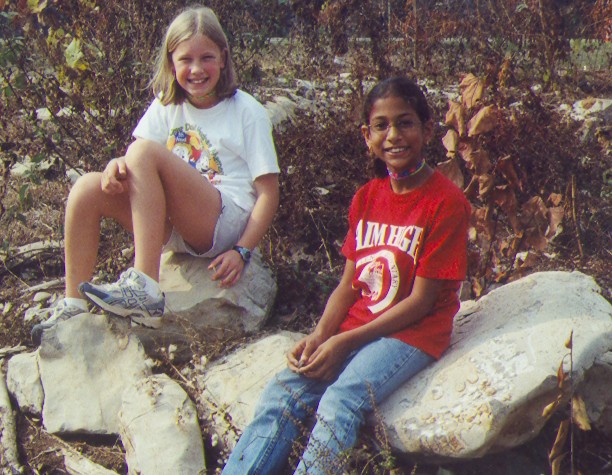
Katie and Nina, very happy with their finds! Note the large coral head underneath Nina!
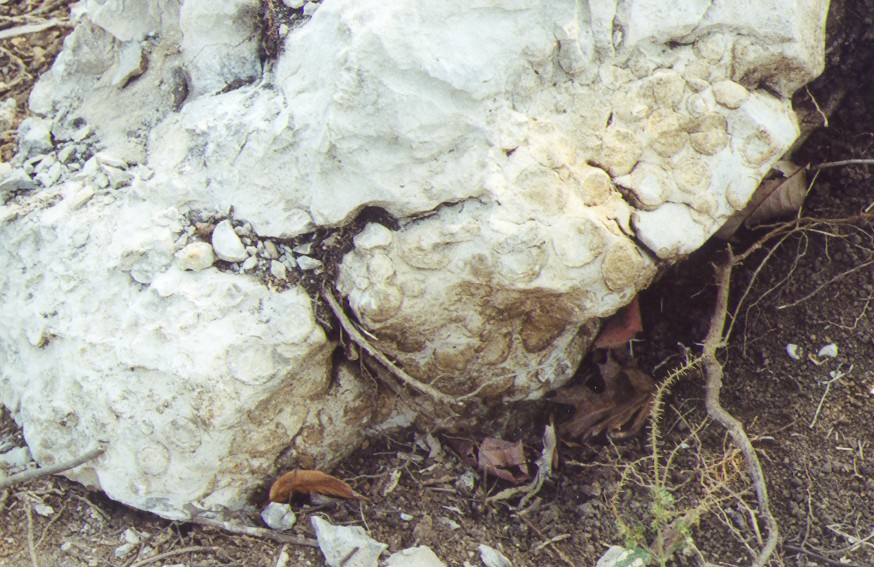

Stop #2 was a short stop, yeilding several samples of archimedes and crinoid stems, also from the Bangor Limestone.



Jan and Claire inspecting this outcrop
.

Bailey has found a nice archimedes.

Vicki in her favorite environment, surrounded by rocks!
Stop #3 was a roadcut in Colbert County. Horned corals, blastoids, and crinoid stems were plentiful.

The fossils weather out, and can be found laying on top of the ground.


Greg is identifying specimens for some of the students.
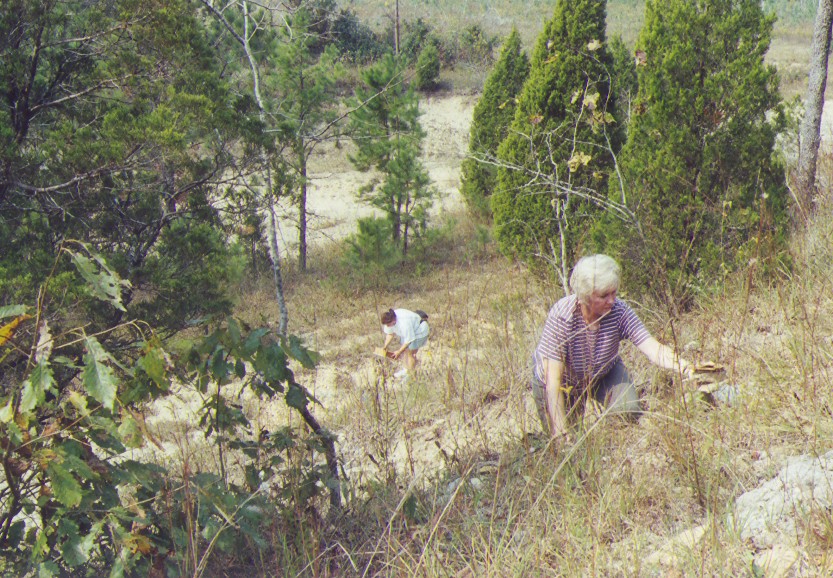
Jan climbing the hill, with Leisa in background.
Stop #4 was a different roadcut, and yeilded similar material as stop #3, such as archimedes, blastoids, brachiopods, and bryazoan fragments.


Bobby found a nice trilobite at this site.
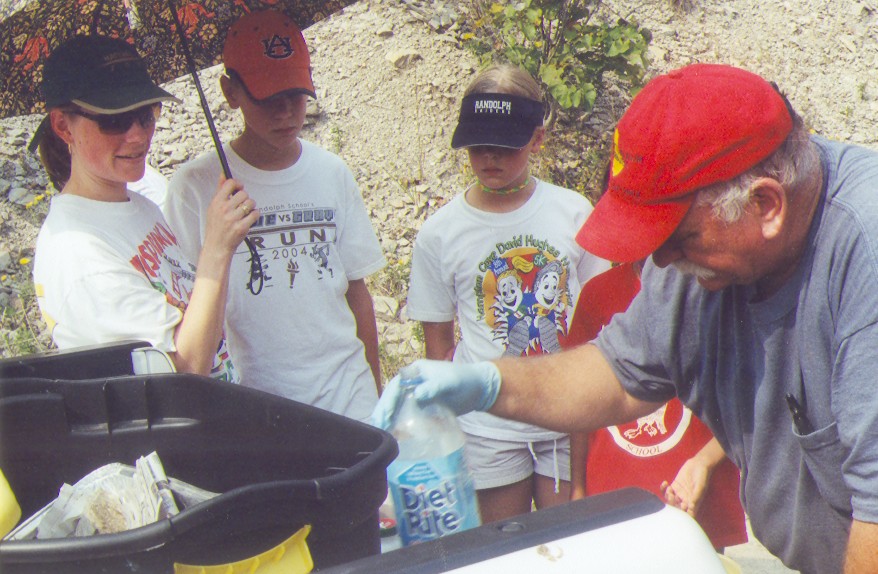
Greg is giving a short tailgate workshop on how to clean the limestone slabs found at this site with a light acid wash (that is not Diet Rite in that bottle!). Acid makes the fossils stand out nicely, but be sure to wear protective gloves and work clothes, and get proper training before trying this at home.
Stop #5 was also in Bangor Limestone, and provided a number of slabs containing broken bits of archimedes, blastoids, brachiopods, and bryazoan fragments. This site also contained numerous square brownish-red metallic crystals, which we believe to be pyrite. They are approximately 1/8 inch squares, some slightly larger.


On the way home, several of us decided to visit one of the local attractions.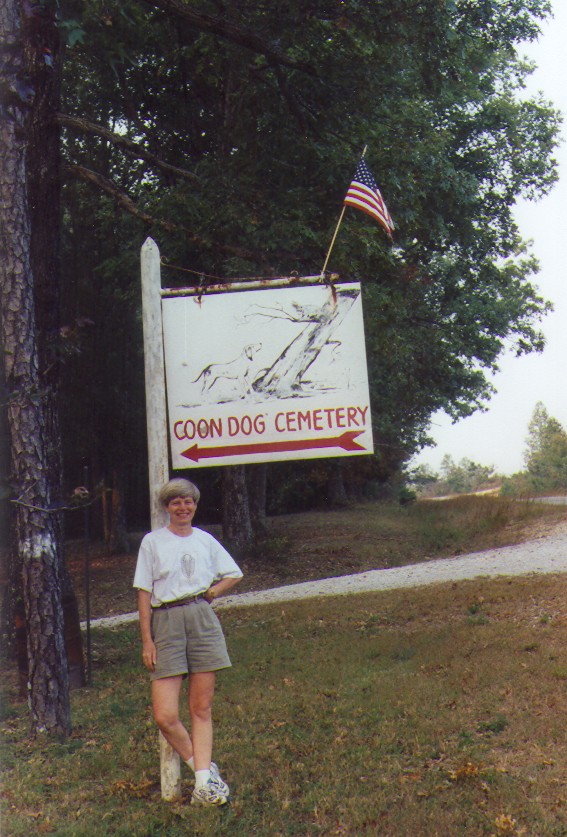
Yep, believe it. Only coon dogs buried here. Decoration day must have occurred recently. In addition to reading the tombstones, one can picnic under the covered pavilion or hike through the woods to the spring.
March 13, 2004 - Mississippian Fossils, Morgan Co, AL
We had a wonderful day of collecting, beautiful weather and great turnout. We went to a new spot in the quarry, in addition to the site from last year. Collecting is in the Mississippian Period (340-310 mya), in a very hard limestone. Every member had great finds, including crinoids (including arms and calyxes), blastoids, brachiopods, coral, and sharks teeth (believe it or not!). Proper prep work will make these specimens stand out beautifully.
(Photos courtesy Steve Corvin, Bill Cunningham, Vicki Lais)

We're ready!
Inside education building, viewing the display.
View of the Tarrant quarry.
BPS members searching in the boulder piles.


Was it worth all the searching? We think so. Nice crinoid.
Rock filled with crinoids and blastoids found by Vicki. Click rock for larger image. 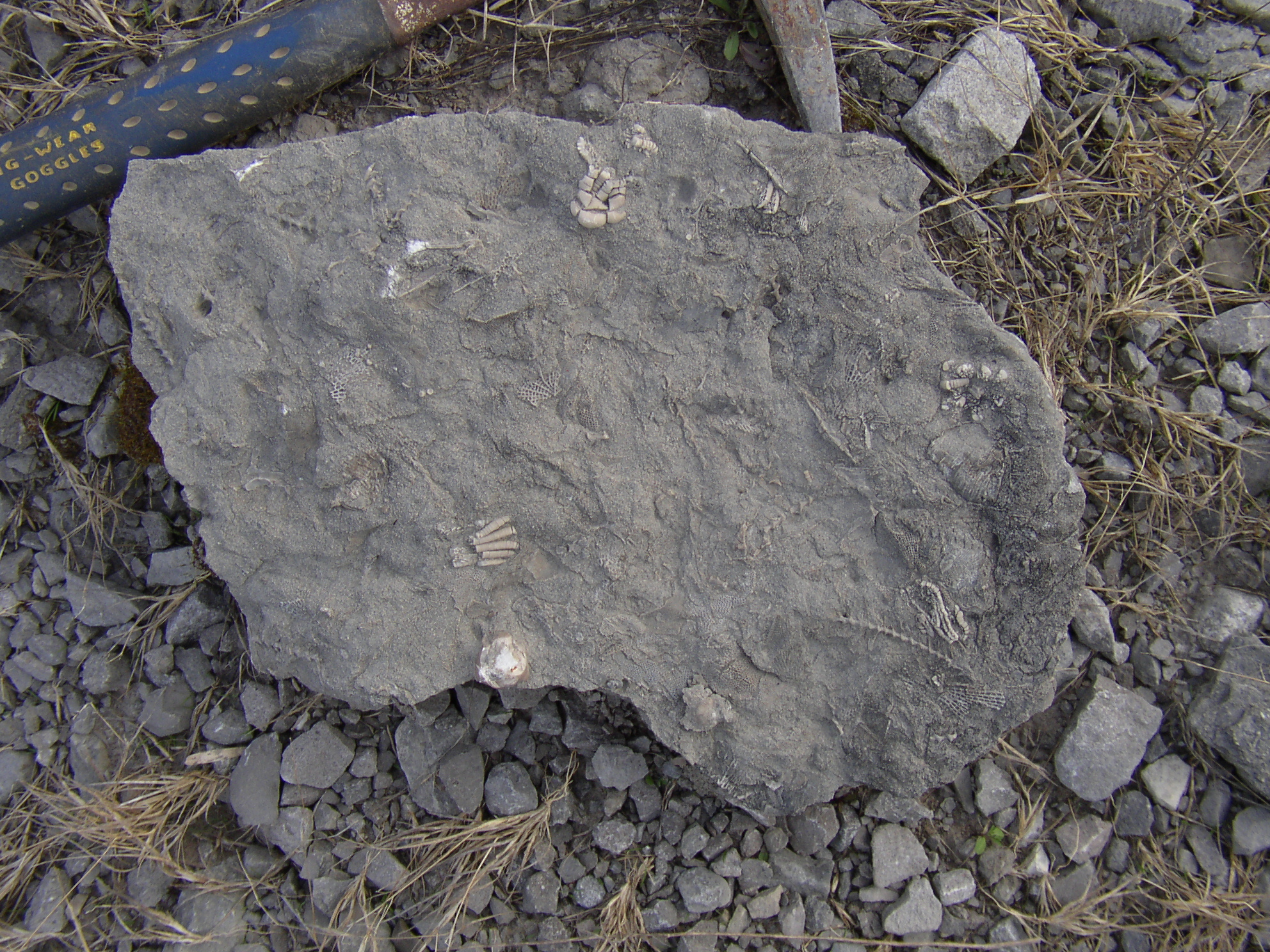
Typical fossils found at this site.




